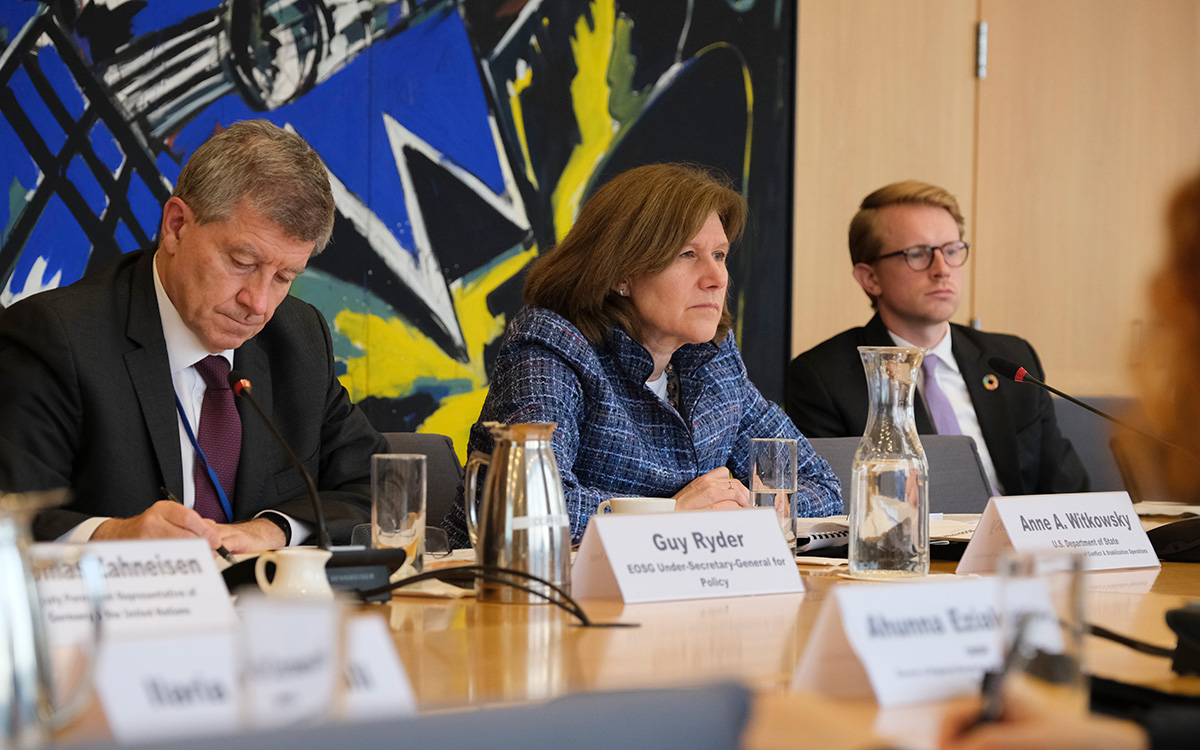Unlocking Resilience: Using Data to Drive Positive Climate Action in Conflict-Prone Regions
The effects of climate change can intensify security challenges in struggling nations. This bureau is using real-time data to predict and prevent crises in vulnerable areas.
BY LUNA RUIZ AND KAYLY OBER

Assistant Secretary of State for the Bureau of Conflict and Stabilization Operations Anne Witkowsky speaking at a CRAF’d steering committee meeting in October 2023 To her right is UN Under Secretary General for Policy Guy Ryder, and to her left is Gray Barrett of CSO’s Office of Advanced Analytics.
UN Executive Office of the Secretary General
The worsening effects of climate change are disproportionately affecting fragile, conflict-affected, and vulnerable (FCV) areas. Resilient states—those that engage constructively with their citizens, maintain functioning institutions, and provide essential services—have the capacity to absorb shocks and manage stresses, maintaining political stability and preventing conflict. In already fragile states, however, the changing climate can intensify security challenges, overwhelming struggling governments and increasing the risks of violence, instability, and conflict. Within the State Department’s Bureau of Conflict and Stabilization Operations (CSO), new programs are being developed to gather real-time data that can be used to advance policy and to predict and circumvent potential crises in at-risk nations.
Repercussions of Climate Change
Climate change effects are not isolated occurrences. Rather, they interact with additional pressures and contextual factors, resulting in diverse compound risks. This complexity is notably pronounced in FCVs, where the effects of climate change and conflict are mutually reinforcing, creating a dual burden. The factors that make a place vulnerable to conflict (e.g., exclusive political institutions, low economic development, inequitable distribution of vital resources) are the very same factors that make a place vulnerable to climate change. The ramifications of conflict, spanning both physical destruction and institutional breakdown, exacerbate the deterioration of systems crucial for resilience against climate-related shocks.
Compound Climate-Fragility Risks Include:
• Resource competition coupled with high population growth, geopolitical tensions, or intergroup rivalries may increase the likelihood or severity of conflict. Clashes over land, water, or other climate-affected resources may be localized (e.g., farmer–herder clashes in West Africa), regional, or international.
• Livelihood insecurity driven by changes in weather patterns can lead to shifting migration routes, increased reliance on illicit income sources, higher rates of gender-based violence, and vulnerability to recruitment by violent extremist organizations. For example, in the Karamoja region of East Africa, the decreasing viability of typically male livelihoods has led some men to appropriate women’s resources and businesses, sometimes using physical force.
• Extreme weather events and disasters increase fragility by decreasing economic opportunities and destroying assets, exposing ineffectual governance, increasing marginalization, or displacing certain populations. Fragile states often lack the resilience to withstand such shocks, and malign actors may step in to fill the void. In some drought-affected countries, insurgent groups are seeking to increase their credibility by mediating resource-related disputes.
• Transboundary water tension may be exacerbated between riparian states as increasingly scarce water resources collide with mismanagement in the service of short-term political gain. Prominent examples include the Euphrates and Tigris rivers, the Blue Nile River Basin, the Jordan River Basin, and the Lake Chad Basin.
• Volatile food prices and rising food insecurity, partly driven by climate change–related decreasing crop yields and disrupted food production, create dangerous cycles of risk. In Burkina Faso, violent extremist organizations have driven farmers out and prevented harvests from being collected, further compounding food insecurity.

At a CRAF’d meeting in October 2023, from left: Gray Barrett of the State Department’s Office of Advanced Analytics; Assistant Secretary Anne Witkowsky; and Mark Slezak, from USAID’s Bureau for Humanitarian Assistance.
UN Executive Office of the Secretary General
A Data-Driven Whole-of-Government Approach
The Bureau of Conflict and Stabilization Operations leads U.S. efforts in conflict prevention. CSO’s climate fragility team works with scientific agencies to identify and mitigate the unintended consequences of climate change and promote peace in vulnerable communities. The team prioritizes work in Libya, Haiti, Mozambique, Papua New Guinea, and across Coastal West Africa, including in Togo, Benin, Ghana, Guinea, and Côte D’Ivoire, using a data-driven approach to foster innovation, collaboration, and evidence-based decision-making in addressing climate fragility.
The 2019 Global Fragility Act (GFA) and subsequent U.S. Strategy to Prevent Conflict and Promote Stability (SPCPS) recognize the nexus between climate change, environmental degradation, population displacement, weakened governance, and conflict in four priority countries and the Coastal West Africa region. The SPCPS’s 10-year framework facilitates long-term planning, sustains partnerships, and emphasizes adaptation efforts, signaling a commitment to address evolving challenges.
The SPCPS also prioritizes learning, data-driven analysis, diplomacy, and information-sharing to understand local dynamics and target interventions. In service to this, the United States became a founding donor of the United Nations Complex Risk Analytics Fund (CRAF’d), a new multidonor trust fund mechanism to find innovative data solutions to complex challenges through pooled investment.
In April 2023, CRAF’d donor partners invested a collective $4 million in five new data projects that examine multidimensional climate fragility risks, focusing on environmental early action tracking, multihazard information aggregation, climate-induced displacement risk modeling, and geospatial climate assessment and early warning dashboards. The five projects are:
• Environmental Early Action and Risk Tracking Hub (EEARTH). Piloted by the International Crisis Group in Somalia and South Sudan, EEARTH will identify climate security risks and pathways to conflict risks, combining quantitative and qualitative information to create a climate-security early warning system.
• Violence and Impact Early Warning System–People in Need (VIEWS-PIN). This program from the Peace Research Institute Oslo fills a critical gap between forecasting natural disasters and conflicts and predicting their effects on nearby populations. The early warning system will estimate the effect of armed conflict and climate shocks on GDP per capita and access to water, health care, education, and food.
• INFORM Warning. This risk-monitoring tool from the United Nations Development Programme (UNDP) presents multihazard information from a wide range of sources to provide insights on global risk trends, forecasts, scenarios, and events, helping crisis response stakeholders stay ahead of potential complex risks and make informed decisions on resource allocation.
• CLIFDEW-GRID. Developed by the UN High Commissioner for Refugees for use by humanitarian actors, governments and policymakers, researchers, and academics, CLIFDEW-GRID is pioneering the development of the first risk index for forced displacement due to slow-onset hazards in West and East Africa.
• Geospatial Dashboards for Climate Assessment and Early Warning (GEOGUARD). Developed by the UN Department of Political and Peacebuilding Affairs’ Innovation Cell and academic partners, GEOGUARD will provide insight on environmental risk factors by coding data points on environmental conditions and geocoded conflict in a database used by the UN and its in situ partners in 29 countries across target regions.
Investing in this area enables us to make more informed, evidence-driven decisions.
The information gleaned from these five projects will help turn early warning into early action, including in the countries and region selected as priorities under the Global Fragility Act. Although integrating physical and environmental data with social science data poses challenges, investing in this area enables us to make more informed, evidence-driven decisions. The projects funded through CRAF’d exemplify this approach. The emphasis on collaboration and information-sharing underscores the collective responsibility in addressing climate fragility risks. Through partnerships between governmental agencies, research institutions, and humanitarian organizations, we can foster a holistic understanding of complex risk landscapes. This collaborative ethos not only enhances our capacity for early warning but also facilitates coordinated response efforts, amplifying the efficacy of interventions.
Early warning systems serve as crucial tools for identifying and responding to climate-related threats before they escalate. By integrating climate and environmental data into decision-making processes, stakeholders can better address climate-related risks, make educated decisions about intervention and support, and promote peace and stability.
From Data Collection to Policy and Programming
CSO’s Office of Advanced Analytics collaborates with interagency partners to conduct comprehensive research on the human security implications of climate change, informing evidence-based interventions and promoting sustainable peace and security. Recent efforts include a partnership with the National Geospatial-Intelligence Agency and the Department of Defense to study herder vulnerability to climate hazards in West Africa. By analyzing patterns of climate-related shocks and seasonal changes, we were able to identify emerging risks and vulnerabilities, empowering communities to proactively mitigate potential conflicts.
This commitment to data-driven policymaking extends to the grassroots level, recognizing the importance of engaging local populations to develop sustainable solutions. An example of this approach is the pilot climate security program launched in border communities in Benin. The program aims to reduce the risk of conflict and promote resilience at the local level by strengthening communication between farmers and herders and incorporating early warning and climate data into traditional mediation processes. The program seeks to empower women as community dialogue facilitators, ensuring that diverse voices are heard and included in conflict prevention efforts.
The interplay between climate change and conflict in fragile and conflict-affected states necessitates a nuanced and data-driven approach to promote stability. By coordinating relevant stakeholders, integrating early warning systems, and promoting local solutions, data miners at the Bureau of Conflict and Stabilization Operations aim to not only enhance societal resilience but also save lives and resources.
When sharing or linking to FSJ articles online, which we welcome and encourage, please be sure to cite the magazine (The Foreign Service Journal) and the month and year of publication. Please check the permissions page for further details.
Read More...
- “On CSO’s 10-Year Anniversary: Stabilization Operations in Perspective” by Robert D. Faucher and John H. Mongan, The Foreign Service Journal, October 2021
- “IOM and CRAF'd Partner to Enhance Data-Driven Responses to Displacement,” UN International Organization for Migration, April 2024
- “Toward Data-Informed Multilateral Diplomacy” by Paula Osborn, The Foreign Service Journal, June 2024





